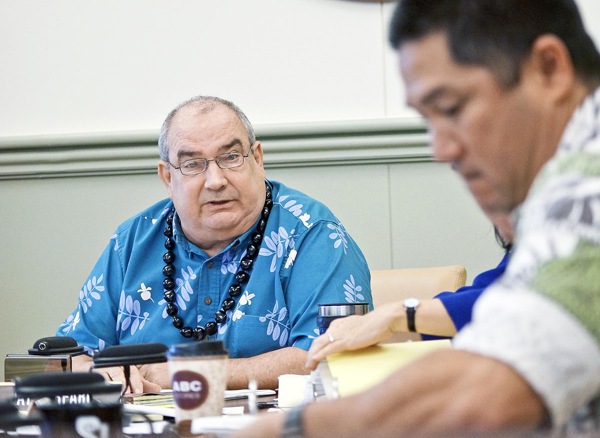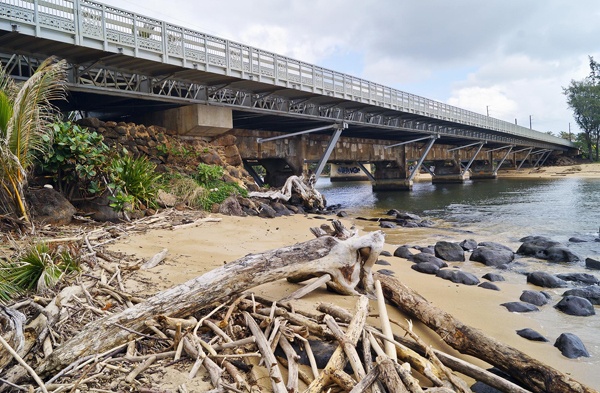LIHU‘E — When it comes down to public money, it’s never water under the bridge for Kaua‘i County Council members, who fired much criticism toward the county Public Works Department Monday for overspending on two bridges due to design flaws.
LIHU‘E — When it comes down to public money, it’s never water under the bridge for Kaua‘i County Council members, who fired much criticism toward the county Public Works Department Monday for overspending on two bridges due to design flaws.
The department, made up of six major divisions, presented the council its $10.88 million budget for operational expenses for Fiscal Year 2014, which starts July 1. But much of the council’s criticism fell under capital improvement projects.
Councilwoman JoAnn Yukimura said she and other council members were “shocked” about the $12 million price tag to replace Kilauea Bridge. The high cost was partially due to design flaws that had to be corrected.
“It was a complex issue, and bridges are complex,” she said.
Rather than discuss past projects, Councilman Tim Bynum said he is “more concerned about future bridges.”
Kapa‘a resident and self-described “nitpicker” Glenn Mickens said the county could have saved millions of dollars by replacing the Kilauea and Olohena bridges with Acrow bridges, similar to the Mayor Bryan Baptiste Memorial Bridge over the Wailua River.
To Mickens, the county wasted more than $100 million on “illegal paving” of roads, which he said are not up to code.
Mickens described the county’s decision to continue repaving — rather than resurfacing — as a “gross waste” of taxpayers’ money.
“I think we have some of the worst roads,” Mickens said, adding that without proper funding the 300 miles of county roadways will never be properly resurfaced.
Monday marked the second day of the Kaua‘i County Council’s review of Mayor Bernard Carvalho Jr.’s proposed budget for FY 2014.
County Engineer Larry Dill said recent achievements within the department include the installation of the Koloa crosswalk, the Waimea Wastewater Treatment Plant expansion and a projected $480,000 decrease in overtime costs.
“Of course, we still have a lot of challenges in the Department of Public Works,” said Dill, including planning for future improvements while continuing to meet the needs and demands of the community.
“We have a very educated community here and they’re well aware of things that need improvement out there,” he said. “And so they are not shy about letting us know those things.”
Yukimura said she was “particularly disturbed” about the objectives listed for the Solid Waste and Roads divisions, which she said are identical to those listed last year.
“I am amazed that there is no zero-waste objective,” said Yukimura. “There is no goal that I have seen for zero waste.”
Bynum encouraged Public Works to look into GPS tracking for county vehicles, which would dramatically improve worker safety and accountability.
Dill said out of approximately 320 department positions, 15 are currently vacant but funded.
“The funded, vacant positions are a concern,” Councilman Mel Rapozo said.
Councilman Gary Hooser said that despite his requests in February and March, he hasn’t seen any budget items for pesticides purchased by the department.
“I believe the only division in Public Works that uses pesticides … is our roads division,” said Dill, who agreed to have that information available within a week.
Council Vice Chair Nadine Nakamura had concerns with the time frame listed for the department’s goals and objectives.
“It would be helpful if you could go through those (goals) and say ‘by when’ … We don’t have a sense of what actually was done,” she said.
Engineering Division
Wallace Kudo, chief of Engineering, said upcoming initiatives include the preparation and adoption of the Complete Streets Manual and the implementation of Safe Routes to School Program.
Councilman Ross Kagawa said he was concerned about drainage issues on Lawa‘i Bypass Road, where a large amount of water spilled over the roadway following heavy rains.
In that particular location, Dill said the roadway was designed to function as a fjord crossing during a 100-year flood.
“It was doing exactly what it was intended and designed and approved to do,” he said.
Rapozo agreed with Kagawa that the culvert presented a safety hazard to children and that he would like to see a fence constructed around it.
Other topics included several bridge projects, including ‘Opaeka‘a, Pu‘u‘opae and Kapahi.
Building Division
Douglas Haigh, chief of the Building Division, said Kaua‘i’s building industry is “gaining steam” and that the implementation of an electronic plan review system for building permits will be a “game changer” moving forward.
Haigh said one of his biggest concerns within his department is in upper management, where several individuals are nearing retirement.
Yukimura expressed her concern with the division not having a system for keeping track of preventative maintenance work.
We also need a system so that when someone leaves there’s a structure that can be turned over, she said.
Rapozo questioned the division about its plans for the Hanama‘ulu Beach Park pavilion and said the community has been asking when that project would get under way.
Haigh said the plan was to demolish and rebuild the pavilion.
Wastewater Management Division
One main topic of discussion during Edward Tschupp’s presentation on the Wastewater Management Division’s budget proposal was odor control measures for the Coco Palms sewage pump station.
“That odor thing … when you go to that bakery and you’re competing with fresh baked good and the smell of sewage, it’s not very conducive to the bakery operation,” Bynum said. “This is like a seven or eight year issue … and I’m not hearing a commitment to do anything about it now.”
“I can say that we have learned more about systems and what can be done, and we haven’t settled on a solution for Kinipopo at this point,” Tschupp said in response.
Automotive Division
On Monday, council members said they were most impressed with the achievements of the Automotive Division, which has an 80 percent on-time completion for repairs and maintenance service.
“Eighty percent is a great number,” Rapozo told Dwayne Adachi, superintendent of the division. “Obviously you run your shop well.”
Additionally, the division has an average repair turnaround of four days and averages one industrial accident per year.
Yukimura congratulated Automotive, saying it was the only division with completely new initiatives from last year.
During the presentation, Adachi discussed the purchase of a new computerized fuel management system, which is scheduled to be up and running in two months and will manage all refueling transactions for county-owned vehicles and equipment.
One of the biggest challenges facing the department is operating efficiently in a limited space and with an inventory that has increased by 30 percent over the last 30 years, Adachi said.
Roads Division
Hooser told Edmond Renaud of the Public Works Roads Division that he wants to see more roads paved for less money, with no tax increase, drawing laughter from the audience.
When it comes to repairing roads, Renaud told the council that the money his division receives annually is not enough to do serious “damage.”
Renaud discussed the ongoing inspection and inventory of all Kaua‘i’s existing roads, which includes identifying problem areas and pinpointing public safety concerns.
He said the information will be gathered over the next year.
“We went a period of almost three years not paving any roads, or resurfacing any roads … I would prefer that you continue to resurface until we have the data,” Furfaro said.
• Chris D’Angelo, lifestyle writer, can be reached at 245-0441 or lifestyle@thegardenisland.com.



